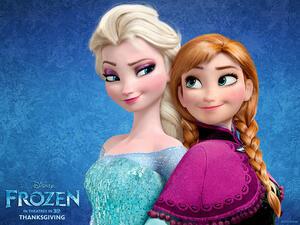Frozen and Feminism on Screen
When my family wanted to go see Frozen, Disney’s newest animated feature, over Thanksgiving weekend, I went along only grudgingly. Judging from the trailers and the product placement I had seen around my local drugstores, all I could tell about Frozen was that it would involve a princess and a wisecracking snowman cavorting across a wintry landscape. Nothing too memorable or extraordinary, I figured.
Happily, I was wrong.
Deceptive marketing aside, Frozen turns out to be a very empowering, moving story with feminist overtones. The plot involves a princess named Anna who embarks on a quest to save her kingdom from the powers of her sister Elsa, who has accidentally cast a spell that has brought eternal winter to the land. Anna (voiced by Kristen Bell) is a marvelously appealing character—she is plucky and brave, but also scared and vulnerable. She loves her sister, but she is also wary of Elsa’s dangerous powers. She works together with a male love interest to achieve her goals without being rescued or controlled by him. In a word, she feels very real.
Ditto to Elsa, who is the closest thing the movie has to an antagonist. Elsa is terrified of her own powers. She too loves her sister but isolates herself to protect Anna from what she perceives as the dangers of being too close. (And, as voiced by Idina Menzel, she has some pretty spectacular musical numbers.) It is this complex but enduring relationship between the sisters that truly drives the story. (It passes the Bechdel Test with flying colors.) The filmmakers knowingly turn a lot of Disney fairytale tropes on their heads—without spoiling too much, let’s just say that Anna’s moment of love at first sight does not turn out the way you’d expect. And that talking snowman I mentioned above? He’s actually pretty funny.
Turns out that theatergoers loved it too – this past weekend, Frozen soared past another big-screen heroine, Katniss Everdeen, to the #1 spot at the box office. But one thing troubles me about this success story—why this misleading marketing? Was Disney trying to play down the feminism of its own movie? Can’t a mature, beautiful Disney film about sisterhood be packaged as such?
The answer may be: not yet. In an era where the Hunger Games movies and Pixar’s Brave showcase strong female leads, the old maxim that men won’t pay to see female-driven movies is still fully in play. Many studios still seem to adhere to the idea that boys won’t see “girl movies,” and Disney is no exception. In fact, the studio’s most recent marketing campaigns seem to be conceived with this idea in mind. The title of 2010’s Tangled was reputedly changed from the original Rapunzel to ensure more cross-gender appeal, and its advertising exaggerated the role of Rapunzel’s male companion despite the fact that, in the film itself, Rapunzel herself is clearly the heroine. Sadly, even the fact that Frozen has two strong female protagonists is unusual for Disney. Scott Mendelson defends Disney’s choice in Forbes, saying that “the marketing campaign clearly worked ... Sometimes you have to hide the vegetables in the pizza sauce.” In other words, these techniques are just a necessary evil. As long as people actually went to see the film and it did well, that’s what counts. Feminism will be palatable, as long as we hide it underneath a tiara. Though it seems a bit patronizing of audiences, Mendelson may have a point—Frozen’s unexpected triumph at the box office probably means that the marketing will ultimately be considered a success.
But it also means that we still have a long way to go. As both Frozen and Catching Fire hopefully pave the way for more feminist film fare, I will be eagerly awaiting the day when strong, awesome female leads onscreen aren’t hidden like “vegetables in the pizza sauce,” but instead are regularly, proudly displayed as the main event.






